or: Where Did Pine Street Come From?
An odd little tidbit in a newspaper from 1928 made us realize we had never written about a building and establishment that practically defined a section of North Pearl Street in Albany for nearly 140 years, and that seems to have been forgotten almost as soon as it was demolished: Drislane’s.
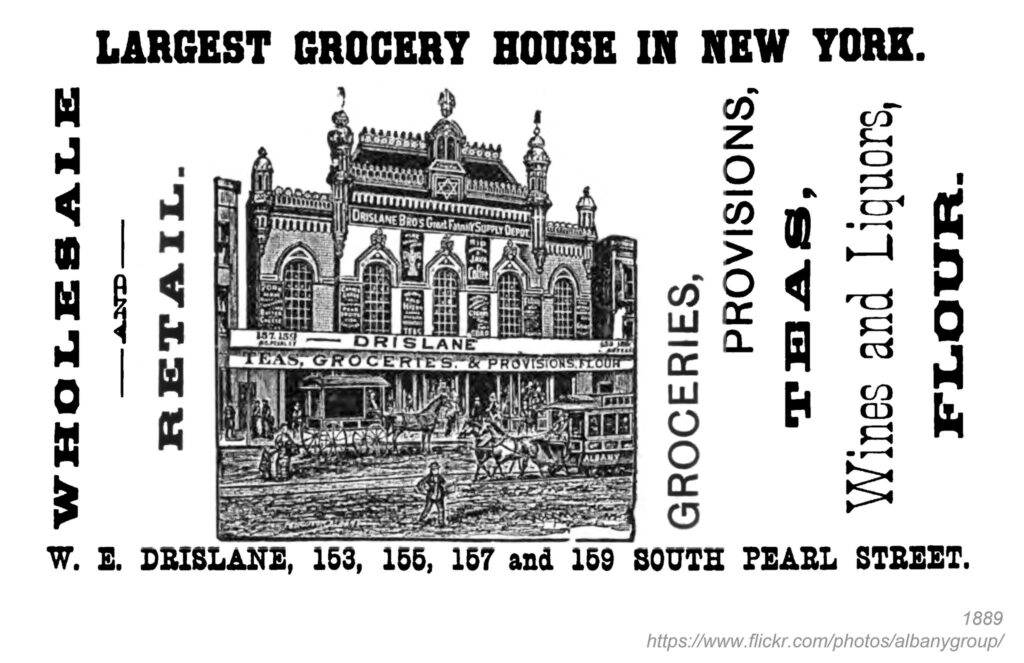
Drislane’s once proclaimed itself to be the largest grocery house in New York, a claim that is hard to verify. But for its day, when grocery stores weren’t terribly large affairs (and most were absolutely tiny), it certainly was huge.
According to a 1962 Edgar Van Olinda column in the Times-Union, William E. Drislane came to Albany from Newburgh, having stores there and in Poughkeepsie. He opened his first Albany grocery store in a former synagogue building at 180 South Pearl Street. From there he moved to the former music hall building, at South Pearl and Beaver, which ended in a major fire in January 1894. It was fortunate that the Albany Female Academy had recently moved to Washington Avenue, leaving their landmark 1834 building at 38-42 North Pearl Street vacant and available for use. The new Drislane’s opened on North Pearl on June 15, 1894.
“A new feature to be found is the Delicatessen for the cooking of different toothsome dishes and where customers may have hams, etc., prepared for the table,” the Times-Union reported. Years later, Edgar Van Olinda wrote that Drislane’s was “the originator of roasting turkeys and chickens, and broiling lobsters, all ready to be sent – or taken – home, warmed up and placed on the table when the little woman had spent a little more time than she had figured on around the afternoon euchre table, the forerunner of today’s game of bridge.” (Oh, the patriarchy.)
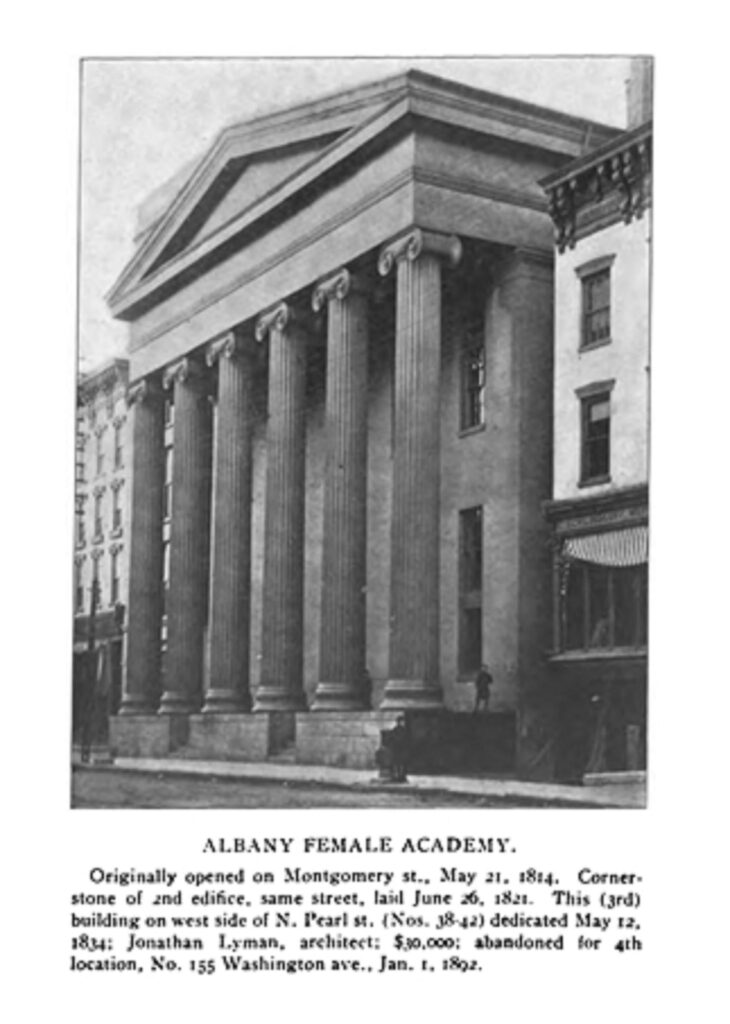
The Drislane building hosted not only the grocery store, but various offices, and throughout its history was used for various government offices. In 1904, the Democratic General Committee took four offices in the building as its headquarters, offering the use of a telephone and daily newspapers to party operatives. “A writing table for general use has been provided, and committeemen and all Democrats are welcome to make use of the conveniences of the rooms at any time.” Fancy. In later years, the comptroller’s office and state courts also had space in the Drislane building.

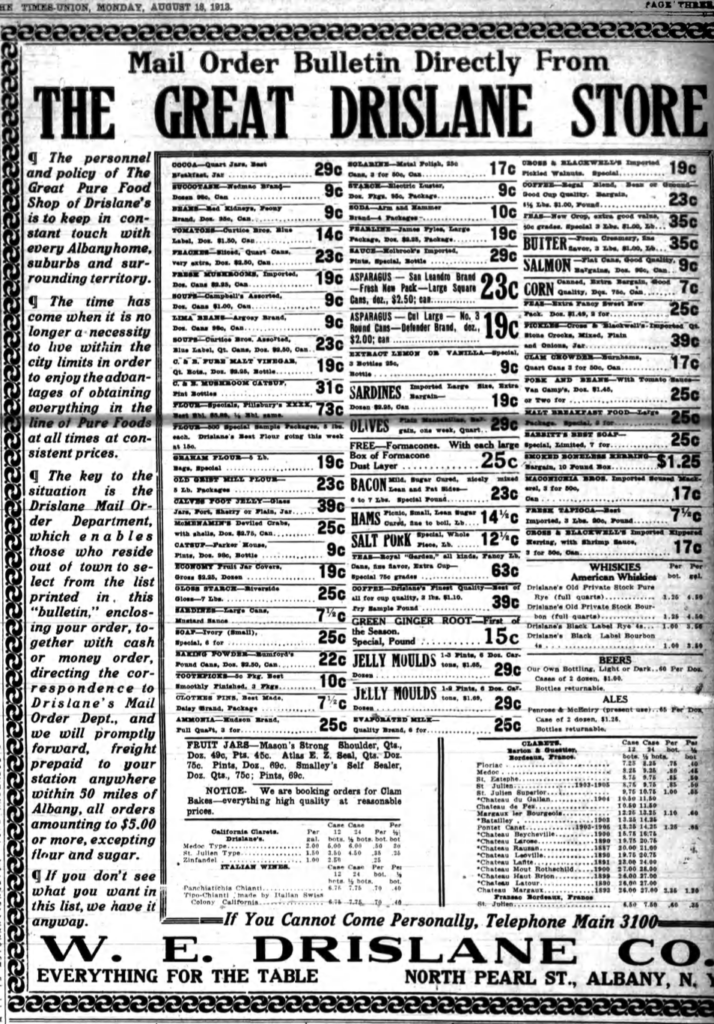
In 1913, Drislane’s was offering a unique service – groceries by mail order. Alongside a list ranging from cocoa to whiskies, Drislane’s explained their “policy”:
“The time has come when it is no longer a necessity to live within the city limits in order to enjoy the advantages of obtaining everything in the line of Pure Foods at all times at consistent prices. The key to the situation is the Drislane Mail Order Department, which enables those who reside out of town to select from the list printed in this ‘bulletin,’ enclosing your order, together with cash or money order, directing the correspondence to Drislane’s Mail Order Dept., and we will promptly forward, freight prepaid to your station anywhere within 50 miles of Albany, all orders amounting to $5.00 or more, excepting flour and sugar. If you don’t see what you want in this list, we have it anyway.”
In 1919, the building’s classical facade was significantly modified by architects Ogden and Gander, with the pediment removed and a brick, stone and terra cotta facade substituted. The front was raised to add a story and large windows as they modernized the grocery store and added rental office space. Property on Chapel Street was acquired some time later, given the store “the entire footage between North Pearl and Chapel streets, with delivery service in the rear.”

Understand that in the early part of the 20th century, Albany was, like any other city, absolutely littered with grocery stores – one 1930s advertisement lists more than 30 in the “central section,” encompassing Center Square and downtown, alone. Of these, Drislane’s was the largest.
Food Shows
Drislane’s hosted a number of “food shows” throughout the years, apparently beginning as early as 1897. These mostly featured the latest in packaged and prepared foods, like cookies, cereals and condiments, as well as baking basics. They also offered enough free samples one could easily make a meal of it. The Knickerbocker Press wrote in 1897:
“Drislane’s is a food show at any time, with its spic-span shelves and counters, its appetizing array of all that is eatable from fish, flesh and fowl, green groceries and bakestuff, to canned goods and candies, salads and spice, and all that’s nice; but last week and this it has taken on an added air of festivity, with rows upon rows of Japanese lanterns to twinkle gaily above, fanciful booths presided over by pretty girls, and hung with gay bunting set up on its big floor space, enticing wonders to tempt the curious, and a pervading, delicious, delectable odor of good things to eat.”
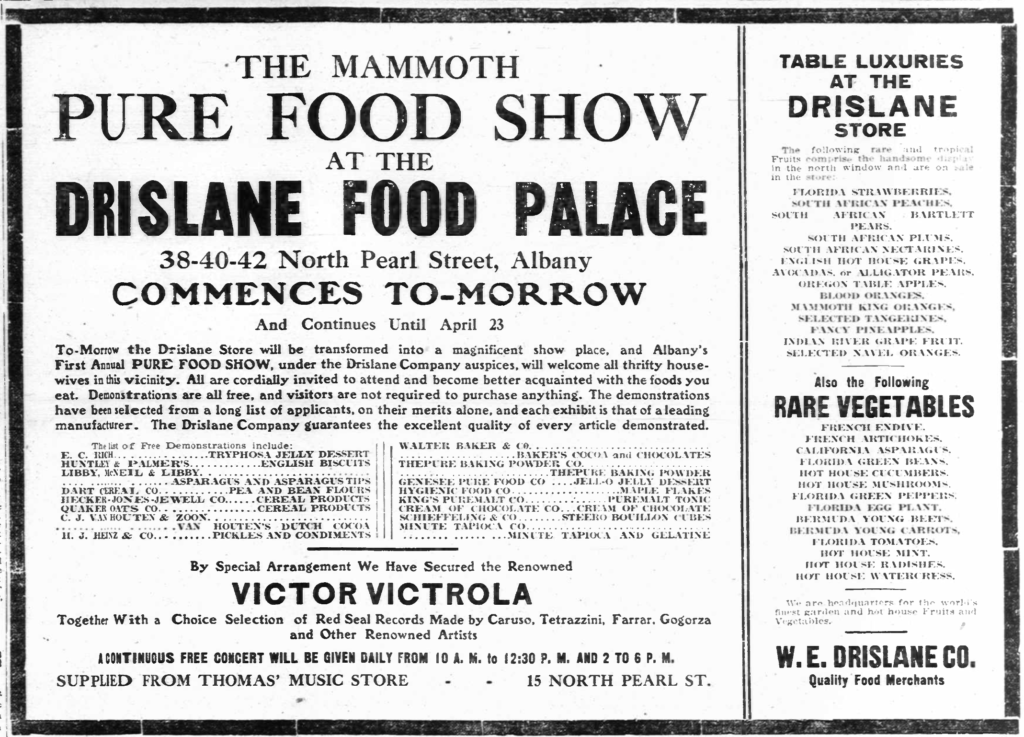
From about 1910 through 1922, it was known as the “Pure Food Show.” Starting in 1930 and running at least through 1932, Drislane’s hosted an annual “Times-Union Drislane Food Show,” a six-day affair in which “experts [were] to demonstrate best methods of preparing nationally known products.” They promised 35 brands of food on exhibit, including “Puffles,” which Drislane’s sought out after a customer asked for them, and which took weeks to find. “They could be obtained from Boston and were just exactly what the customer had said they were – a fried crust enclosing delectable masses of fruits or vegetables.” (“Puffles” seems to have been a kind of fair food that involved some sort of pastry flake that would expand significantly when fried.)
“If you have heard of a certain brand of food and want to try it, come to Drislane’s and you will be able to see the food fixed for the table in its most attractive fashion before your eyes; be able to sample the food and to find out for yourself whether or not you would like to have it on your table. You will no longer have to go into the grocery store and ask the clerk for the best kind of cereal for a person just getting over an attack of pneumonia, or for the most fancy and still healthful kind of cakes for a children’s party which you are going to have at your home next week. The food show is arranged especially for the convenience of the customer who doesn’t know just exactly what she wants, but in a vague way would like to try several things before making final judgment on the type of food which she will serve in her home.”
And what were the mysterious new food offerings for the housewife to sample at the food show? In 1932, there was a demonstration of Bisquick, a new product of the Washburn-Crosby Company, the millers of Gold Medal “Kitchen Tested” Flour “whose Betty Crocker is widely known as an authority on cooking.” Criss-Cross and Pillsbury’s were also offering flours. There were Blue Label foods – easy pouring ketchup in a wide mouthed bottle, a tomato juice cocktail, chicken in tins, jellies, preserves and chili sauce. The Loose-Wiles Biscuit company had a booth featuring Krispy crackers, Edgemont graham wafers and Sunshine Hydrox cookies (universally thought of as “the poor man’s Oreo,” although they actually predated Oreos). There were Echo Brand canned vegetables, with the “superior flavor and quality characteristic of Western New York.” West Albany’s First Prize meats were there as well. There was Junket, from Little Falls, which “makes milk into delicious desserts.” And there was Williamstown, Massachusetts’s Sand Springs beverages, offering “ginger ale made from pure fruit carbonated beverages and the new vichy made from Sand Springs water.” Why, scientific research showed that Sand Springs water had the “greatest evidence of radio activity found in any commercial water, foreign or domestic, or natural origin.”
Promotional copy sure was different a century ago.
Champion Coffee Drinker
It was running across this little tidbit that aroused our interest in Drislane’s: In 1928, Albert A. Baker, “World’s Champion Coffee Drinker,” came to Drislane’s to try to break his 280-cup coffee drinking record.

“With a world’s record behind him of having drunk 280 cups of coffee in four and one-half hours, Albert A. Baker, champion coffee consumer, makes his bow to Albany on Tuesday, when he will attempt to better his own record in the window of Drislane in North Pearl street. During the noon hour, from 12 to 1, Baker will drink the famous Eagle brand coffee, made by Bacon, Stickney and company.”
So no, he wasn’t going to break his record, which he had set in Milwaukee some months before, but at an appearance in Buffalo the week before, he drank 77 cups in an hour. Since “gaining fame along his particular line” two and a half years earlier, when he first set a record of 96 cups in six hours, he estimated he had “put away” about 25,000 cups in appearance in many cities. Coming from New Bedford, Mass. (though he made other claims as publicity suited), he also had eaten 18 dozen eggs in 3-1/2 hours, and claimed to have once drunk 150 bottles of beer followed by ten quarts of ice cream. (We can’t stress enough: no he didn’t, and don’t. You will die.) Did people come to Drislane’s to watch him drink a lot of coffee in the window? Of course they did.
“Coffee is not harmful,” Baker said. “A great many persons imagine continued use of coffee will injure their health, but this is mostly imagination. I drink all my coffee black, and I’m in fine physical condition.”
(We admit we are wildly confused by the advertisement’s assertion that Bacon, Stickney & Co. was Central New York’s principal coffee, tea and spice packer. They were an Albany firm through and through. They even packaged the coffee for the Ten Eyck Hotel, a stone’s throw from Drislane’s. We’re endlessly weary of the upstate/downstate arguments, but Albany is not Central New York.)
The Drislane Building’s Fate
In June 1933, William Drislane, aged 76, suffered from a stroke and died. Son William Jr. and daughter Kitty, who had been running it for a while, continued the business, but it appears that the annual food shows ended, and it seems like Drislane’s started to focus on their liquor and wine sales, and their bakery operation, over groceries. In 1937, the first floor was divided up and largely rented out to The Fashion Shop and Knickerbocker Fashion Hats (there had been talk of J.C. Penney opening there). The bakery went on for some time, at least through 1949, and the liquor store remained until at least 1971. The Drislane Building remained a landmark address with various retail and office tenants until May 23, 1972, when it was demolished for the Ten Eyck Plaza project.

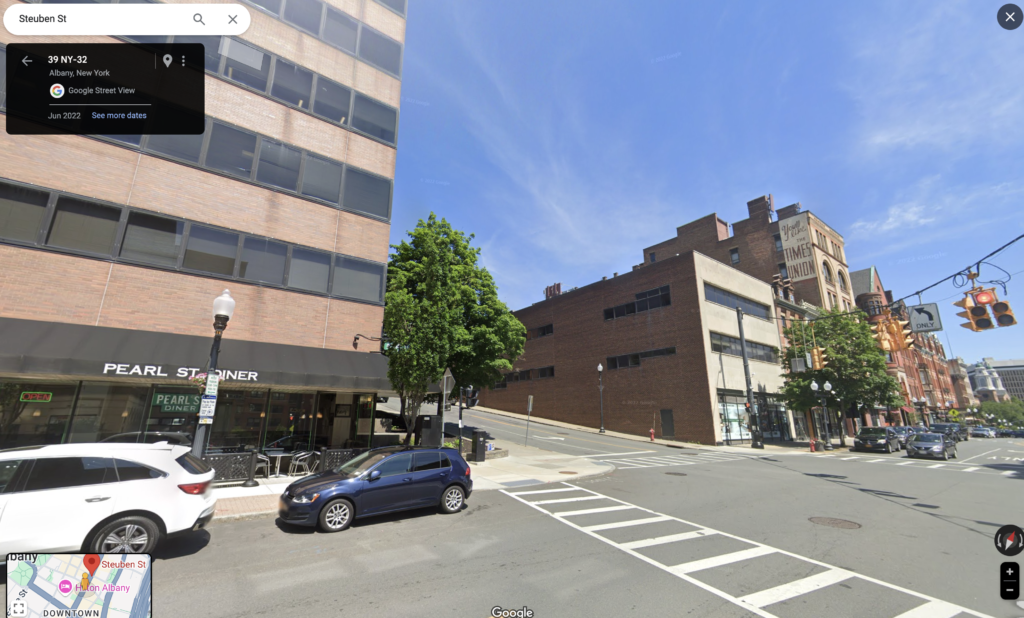
Pine Street
As we were trying to figure out just exactly where the Drislane Building had stood, we used our usual methods – looking at an old Sanborn map, trying to find some nearby buildings that still stand, and interpolating from there. And we noticed something curious that had somehow escaped our attention in thousands of other examinations of Albany maps:
Pine Street previously only went from Elk to Chapel. That’s it. It didn’t go to Pearl, didn’t cross Pearl, didn’t run to Broadway, as it does today. Look, in 1950 – running to the east from Academy Park:
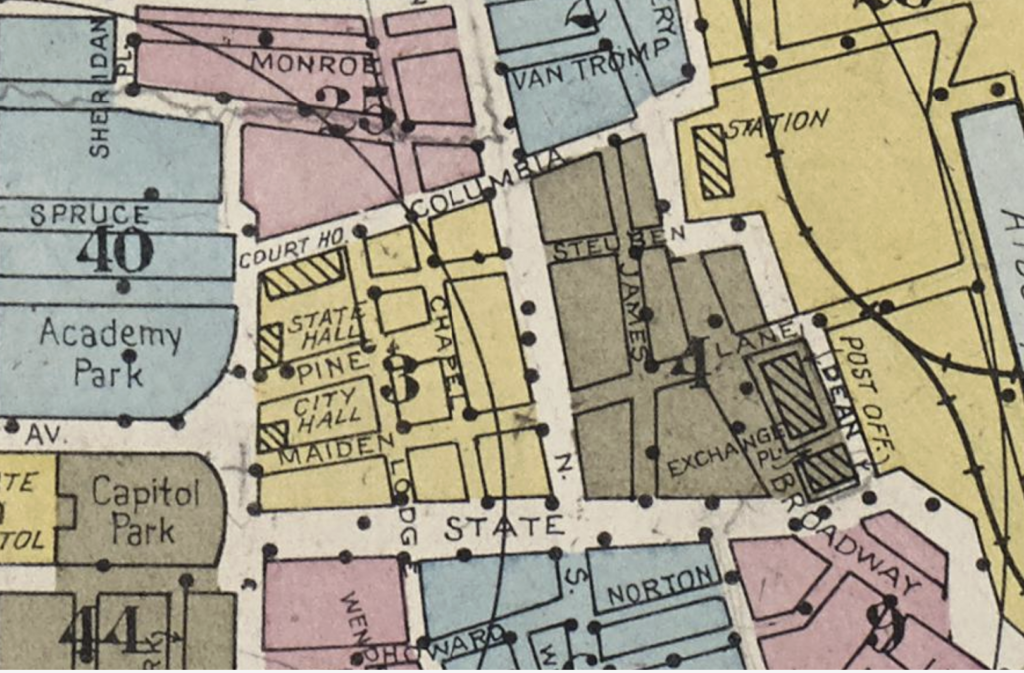
And here’s where the Drislane Building stood:
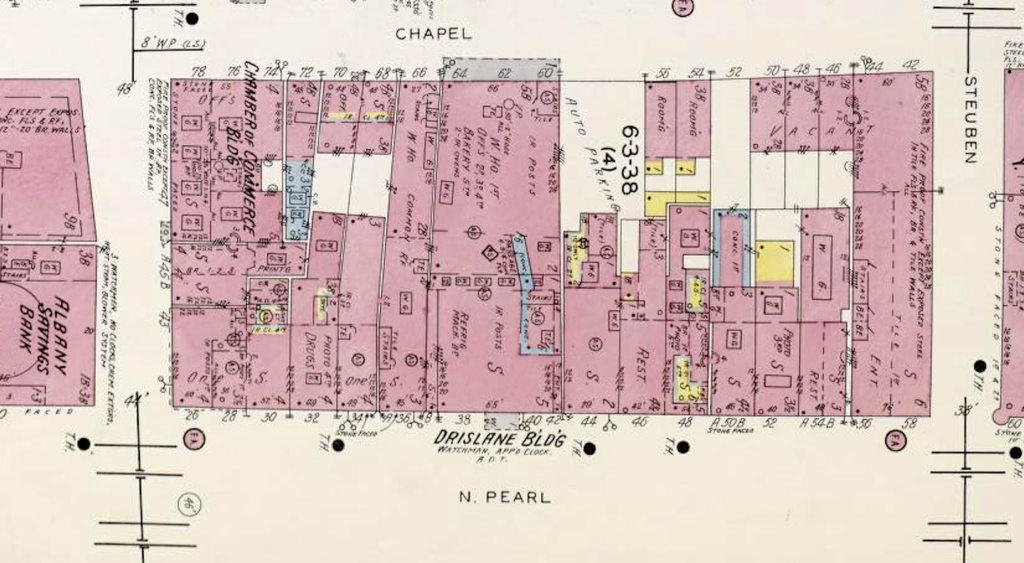
As near as we can guess, the four buildings just left (south) of Steuben still stand, and the buildings at 44, 46, and 48 N. Pearl (roughly) are now taken up by Pine Street.
So, no Pine Street. Based on the information on the development of Ten Eyck Plaza, we would have expected that extending Pine Street through at least to Pearl was part of that project – but that wouldn’t have explained how Pine Street also now goes all the way to Broadway. Nothing in the Ten Eyck Plaza project (which encompassed all the redevelopment on the blocks of Pearl from State to, well, Pine Street, and from Pearl to Chapel) seemed to envision a new, broad street leading to Broadway.
Thanks to Paul Nance, we learned that Pine Street to Broadway came some years later, as part of the plan to turn part of Maiden Lane into a pedestrian mall. According to a Sept. 17, 1980 article in the Knickerbocker News, the Maiden Lane mall plan called for renovation of stores on Maiden Lane between Broadway and Pearl. Pine Street was to run all the way to I-787, following Maiden Lane east of Broadway to the Water Street and then onto the highway. The Pine Street Extension opened with a ribbon-cutting by Mayor Corning on August 18, 1981. Today, of course, that foot of Maiden Lane, as the maps still call it, is also mostly closed to vehicles, and leads to the Hudson River Way pedestrian bridge across I-787. But there is still a weird little stub of Maiden Lane off Water Street that reaches to Dean Street.
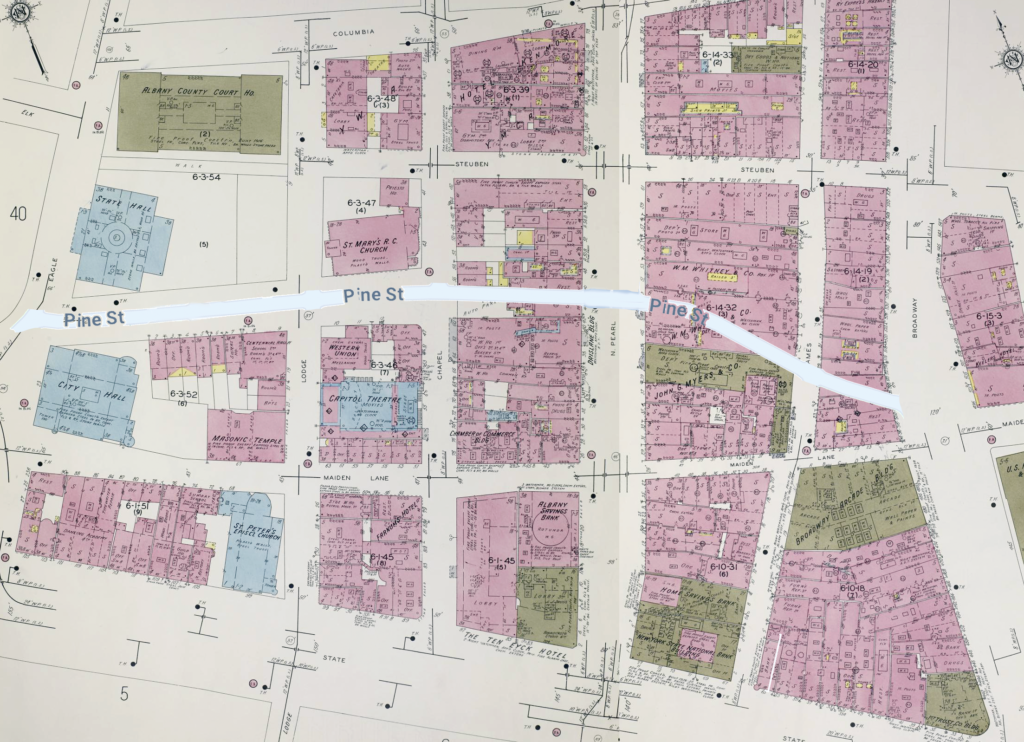

Leave a Reply